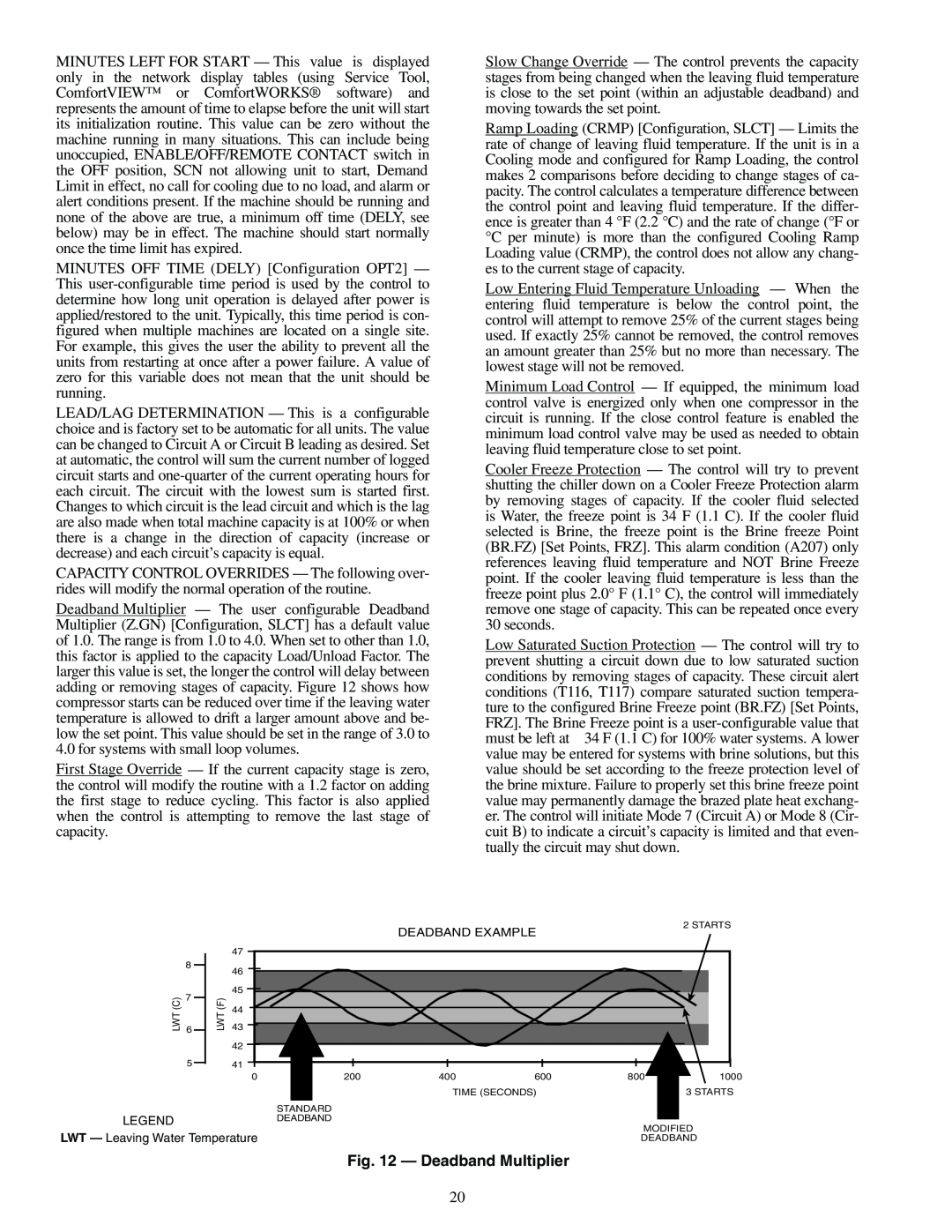
MINUTES LEFT FOR START — This value is displayed only in the network display tables (using Service Tool, ComfortVIEW™ or ComfortWORKS® software) and represents the amount of time to elapse before the unit will start its initialization routine. This value can be zero without the machine running in many situations. This can include being unoccupied, ENABLE/OFF/REMOTE CONTACT switch in the OFF position, SCN not allowing unit to start, Demand Limit in effect, no call for cooling due to no load, and alarm or alert conditions present. If the machine should be running and none of the above are true, a minimum off time (DELY, see below) may be in effect. The machine should start normally once the time limit has expired.
MINUTES OFF TIME (DELY) [Configuration OPT2] — This
LEAD/LAG DETERMINATION — This is a configurable choice and is factory set to be automatic for all units. The value can be changed to Circuit A or Circuit B leading as desired. Set at automatic, the control will sum the current number of logged circuit starts and
CAPACITY CONTROL OVERRIDES — The following over- rides will modify the normal operation of the routine.
Deadband Multiplier — The user configurable Deadband Multiplier (Z.GN) [Configuration, SLCT] has a default value of 1.0. The range is from 1.0 to 4.0. When set to other than 1.0, this factor is applied to the capacity Load/Unload Factor. The larger this value is set, the longer the control will delay between adding or removing stages of capacity. Figure 12 shows how compressor starts can be reduced over time if the leaving water temperature is allowed to drift a larger amount above and be- low the set point. This value should be set in the range of 3.0 to 4.0 for systems with small loop volumes.
First Stage Override — If the current capacity stage is zero, the control will modify the routine with a 1.2 factor on adding the first stage to reduce cycling. This factor is also applied when the control is attempting to remove the last stage of capacity.
Slow Change Override — The control prevents the capacity stages from being changed when the leaving fluid temperature is close to the set point (within an adjustable deadband) and moving towards the set point.
Ramp Loading (CRMP) [Configuration, SLCT] — Limits the rate of change of leaving fluid temperature. If the unit is in a Cooling mode and configured for Ramp Loading, the control makes 2 comparisons before deciding to change stages of ca- pacity. The control calculates a temperature difference between the control point and leaving fluid temperature. If the differ- ence is greater than 4 °F (2.2 °C) and the rate of change (°F or °C per minute) is more than the configured Cooling Ramp Loading value (CRMP), the control does not allow any chang- es to the current stage of capacity.
Low Entering Fluid Temperature Unloading — When the entering fluid temperature is below the control point, the control will attempt to remove 25% of the current stages being used. If exactly 25% cannot be removed, the control removes an amount greater than 25% but no more than necessary. The lowest stage will not be removed.
Minimum Load Control — If equipped, the minimum load control valve is energized only when one compressor in the circuit is running. If the close control feature is enabled the minimum load control valve may be used as needed to obtain leaving fluid temperature close to set point.
Cooler Freeze Protection — The control will try to prevent shutting the chiller down on a Cooler Freeze Protection alarm by removing stages of capacity. If the cooler fluid selected is Water, the freeze point is 34 F (1.1 C). If the cooler fluid selected is Brine, the freeze point is the Brine freeze Point (BR.FZ) [Set Points, FRZ]. This alarm condition (A207) only references leaving fluid temperature and NOT Brine Freeze point. If the cooler leaving fluid temperature is less than the freeze point plus 2.0° F (1.1° C), the control will immediately remove one stage of capacity. This can be repeated once every 30 seconds.
Low Saturated Suction Protection — The control will try to prevent shutting a circuit down due to low saturated suction conditions by removing stages of capacity. These circuit alert conditions (T116, T117) compare saturated suction tempera- ture to the configured Brine Freeze point (BR.FZ) [Set Points, FRZ]. The Brine Freeze point is a
|
|
|
|
| DEADBAND EXAMPLE |
| 2 STARTS | |
|
|
|
|
|
|
| ||
|
|
| 47 |
|
|
|
|
|
| 8 |
| 46 |
|
|
|
|
|
|
|
|
|
|
|
|
| |
(C) | 7 |
| 45 |
|
|
|
|
|
(F) |
|
|
|
|
|
| ||
| 44 |
|
|
|
|
| ||
LWT |
| LWT |
|
|
|
|
| |
6 | 43 |
|
|
|
|
| ||
|
|
|
|
|
|
|
| |
|
|
| 42 |
|
|
|
|
|
| 5 |
| 41 |
|
|
|
|
|
|
|
| 0 | 200 | 400 | 600 | 800 | 1000 |
|
|
|
|
| TIME (SECONDS) |
| 3 STARTS | |
|
|
|
| STANDARD |
|
|
|
|
LEGEND |
|
|
| DEADBAND |
|
| MODIFIED | |
LWT — Leaving Water Temperature |
|
|
| |||||
|
|
| DEADBAND | |||||
Fig. 12 — Deadband Multiplier
20
